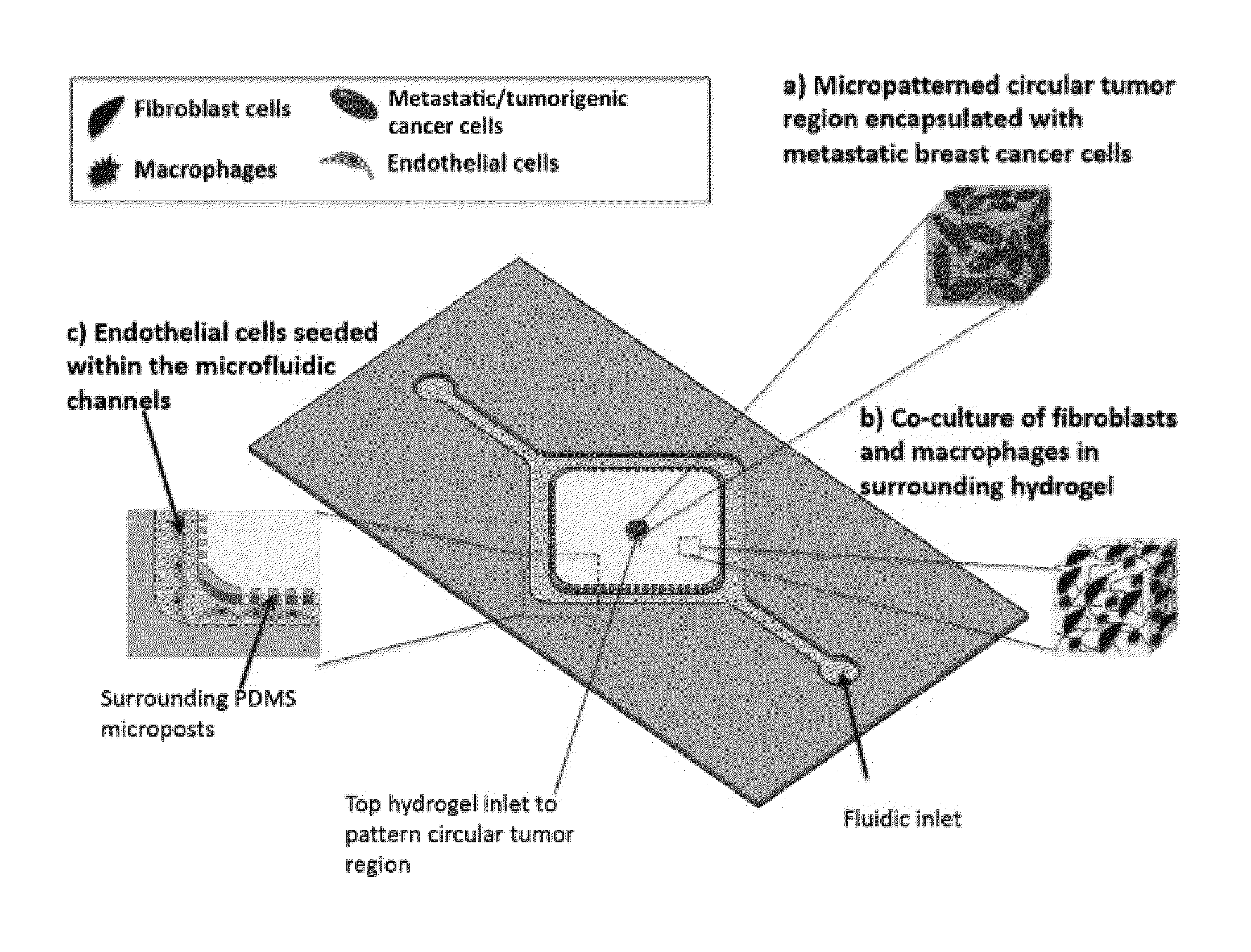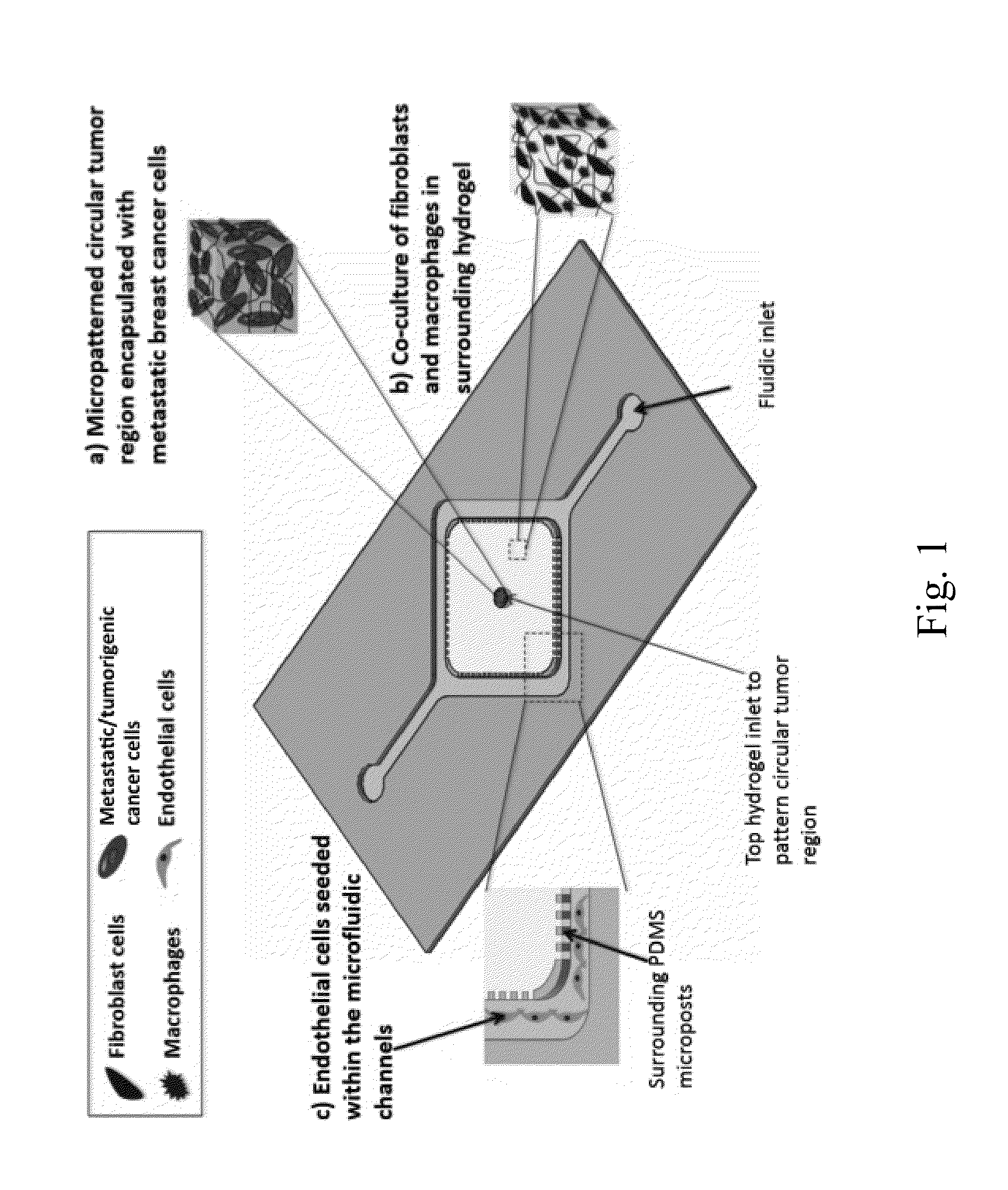Engineering Of A Novel Breast Tumor Microenvironment On A Microfluidic Chip
a microfluidic chip and microenvironment technology, applied in the field of engineering of a novel breast tumor microenvironment on a microfluidic chip, can solve the problems of cancer cell metastasis, difficult independent study of inability to test the effects of various microenvironmental cues using in vivo models, etc., to achieve excellent scaffolding materials, excellent diffusion properties, and excellent mechanical properties
- Summary
- Abstract
- Description
- Claims
- Application Information
AI Technical Summary
Benefits of technology
Problems solved by technology
Method used
Image
Examples
example 1
An Exemplary Microfluidic Device
[0064]In this example, we describe a non-limiting exemplary embodiment of a microfluidic device according to the disclosed invention.
[0065]FIG. 1 shows the features of the exemplary microfluidic device, As shown in FIG. 1, the microfluidic device includes two separate regions of hydrogel constructs, one for the circular tumor construct (neoplastic lesion) encapsulated with metastatic breast cancer cells ((a); center circle), and the second one resembling the surrounding 3D ECM stroma for encapsulation of FBs and macrophages ((b); rectangle surrounding center circle). Two parallel microfluidic channels seeded with ECs are interconnected with the surrounding ECM hydrogel ((c), adjacent to the two long edges of rectangle of (b)). In particular, the microfluidic channels will be used for seeding of ECs resembling the vascular network ((c)). In addition, the microfluidic channels will be used to introduce anticancer drugs for testing.
[0066]Microfluidic Dev...
example 2
Production and Use of an Exemplary Microfluidic Device
[0081]In this proof of principal example, we demonstrate that a microfluidic device according to the disclosed invention is capable producing a well-defined tissue architecture, and that it enables high-contrast and real-time imaging for detailed invasion and intravasion studies.
[0082]Introduction.
[0083]The development of our breast cancer invasion platform has given our laboratory the opportunity to investigate and provide insight to key aspects of the metastatic cascade and tumorigenesis. This study validates our model as breast cancer invasion and demonstrates that our platform is capable of producing a well-defined tissue architecture and enabling high-contrast real-time imaging for detailed invasion and intravasation studies.
[0084]Creating a Spatially Organized Cancer Invasion Platform.
[0085]First, we developed a CAD design that caters to the native breast tumor architecture (FIG. 2A). It consisted of two distinct region mad...
PUM
| Property | Measurement | Unit |
|---|---|---|
| width | aaaaa | aaaaa |
| optically transparent | aaaaa | aaaaa |
| optically transparent | aaaaa | aaaaa |
Abstract
Description
Claims
Application Information
 Login to View More
Login to View More - R&D
- Intellectual Property
- Life Sciences
- Materials
- Tech Scout
- Unparalleled Data Quality
- Higher Quality Content
- 60% Fewer Hallucinations
Browse by: Latest US Patents, China's latest patents, Technical Efficacy Thesaurus, Application Domain, Technology Topic, Popular Technical Reports.
© 2025 PatSnap. All rights reserved.Legal|Privacy policy|Modern Slavery Act Transparency Statement|Sitemap|About US| Contact US: help@patsnap.com



